Far from the bustle of Florence’s historic center, perched atop one of the city’s most scenic hills, lies a place shrouded in an aura of silent sacredness: the San Miniato al Monte crypt. It is here, in the ancient heart of the famed basilica, that the mystery of the site’s spiritual origins is quietly preserved. Dating back to the 11th century, the crypt houses the relics of Saint Minias (the city’s first martyr) whose tomb rests directly beneath the main altar.
The walls, adorned with medieval frescoes (including remarkable works by Taddeo Gaddi, a disciple of Giotto), still whisper of a time when faith and art spoke the same language of pure devotion.

San Miniato al Monte crypt: the hidden heart of the Basilica

Descending from the side aisles of the basilica, down one of the stairways that lead into shadow, you enter a suspended space where time seems to slow: the Crypt of San Miniato al Monte. Nestled beneath the elevated presbytery, this is the oldest part of the church, built in the 11th century and shaped with the precision and elegance of Florentine Romanesque architecture.
Like the basilica above, the crypt unfolds into three naves, yet the atmosphere shifts. The light softens, and thirty-eight columns mark the rhythm of the space, supporting a series of cross vaults that seem to embrace visitors in a hushed, solemn twilight.
Over the centuries, it has drawn both reverent gazes and the hands of artists. In the 14th century, significant embellishments were undertaken, and in 1341, Taddeo Gaddi (Giotto’s favored pupil) painted a cycle of frescoes that still withstand the passage of time and moisture.
Open to visitors, the crypt offers a rare glimpse into a lesser-known side of Florence. Far from the city’s restless energy, one steps into a more intimate and spiritual dimension, where every detail (from the columns to the paintings, from the silence to the stone) invites you to pause, observe, and listen.
History and meaning of the San Miniato al Monte crypt
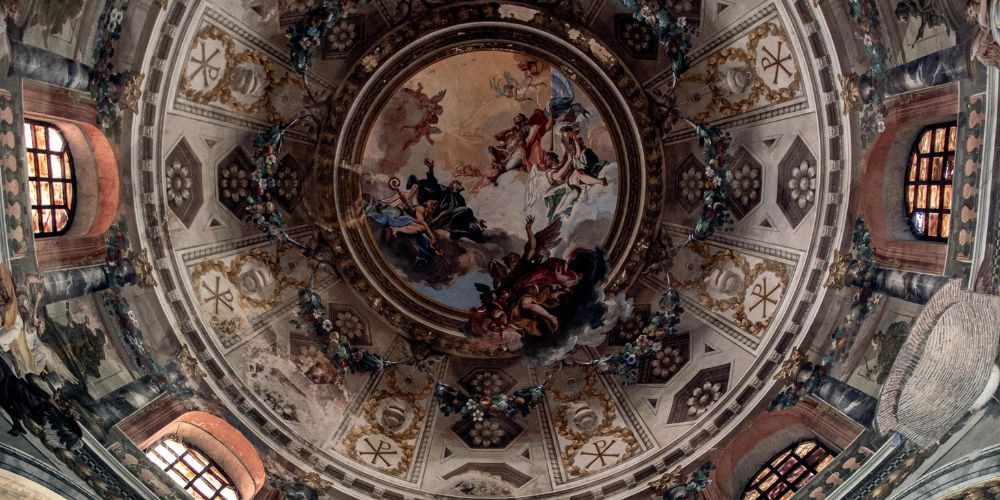
The crypt of the Basilica of San Miniato al Monte traces its origins back to the 11th century, a time when Florence was shaping its religious and artistic identity. It was here that the oldest space of the entire complex was built, a sacred chamber created to house the relics of Saint Minias, the city’s first martyr, whose legacy became a symbol of faith and protection for the Florentine community.
Envisioned as the spiritual heart of the church, the crypt was constructed in the austere and solemn style of Romanesque architecture, with elegant columns and cross vaults supporting the subterranean nave. Located directly beneath the presbytery, it was designed not only as a burial site but also as a place of veneration, a space set apart for devotion and liturgical life.
Despite the centuries that have passed, the crypt still preserves traces of medieval frescoes and decorative details that reveal the desire to safeguard its original beauty and sanctity. Restoration efforts have carefully protected the atmosphere of solemn mystery that continues to make this space unique within Florence’s religious landscape.
Symbolism and art in the San Miniato al Monte crypt

Crossing the threshold of the crypt feels like stepping into an artistic microcosm where everything (from the play of light to the intricate decorations) seems designed to evoke silence and wonder. The walls and vaults preserve precious frescoes, most notably those painted in 1342 by Taddeo Gaddi. His brushstrokes narrate episodes from the life of Saint Minias and scenes from the Gospels, offering an authentic glimpse into Tuscan medieval painting, rich in color and spirituality.
The space is divided into three central naves and four lateral ones, supported by six rows of columns (thirty-eight in total) that uphold the cross-vaulted ceiling. Each column is unique, crowned with capitals crafted from a mix of materials: smooth marble, fluted marble, pietra serena, and Florentine terracotta. Most striking of all is the use of spolia (reused architectural fragments taken from ancient Roman buildings) placed atop the columns, creating a tangible link to the imperial past.
Light enters gently through five small lateral windows, casting shadows that highlight the surfaces and bring out the decorative details. The ancient capitals, sourced from both Florentine and Roman monuments, give the crypt a layered soul, a place where Christian spirituality quietly merges with classical heritage.
Practical information for visiting the San Miniato al Monte crypt
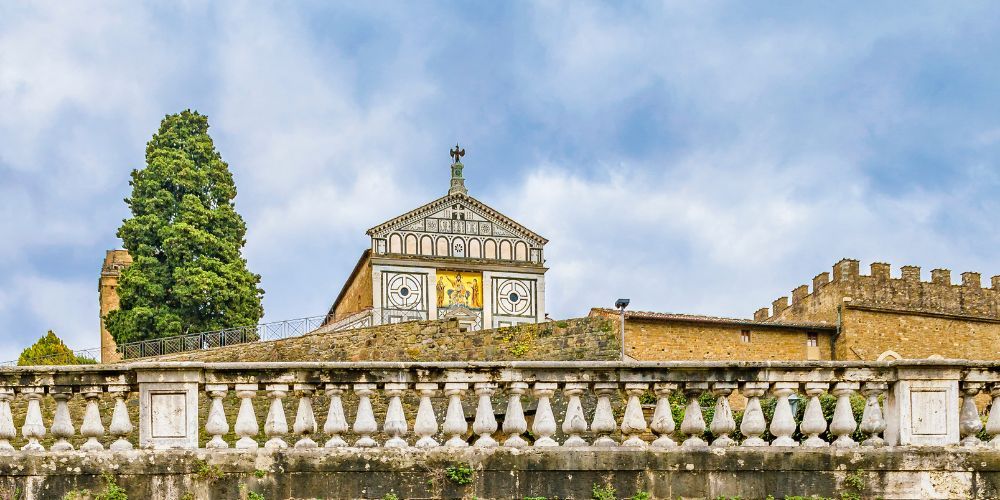
Access to the crypt is available during the basilica’s opening hours: Monday to Saturday from 9:30 AM to 1:00 PM and from 3:30 PM to 7:00 PM. On Sundays and public holidays, the basilica opens earlier, at 8:15 AM, to accommodate religious services.
Keep in mind that during liturgical celebrations, the basilica (and therefore the crypt) is closed to visitors, remaining a place of worship. Entry is free of charge, and no reservation is required for individuals or organized groups.
For those seeking a more in-depth experience through guided tours or special events, it is recommended to check the official website of the Abbey or get in touch directly with the monastic community.
Lesser-Known legends and stories of the San Miniato al Monte crypt
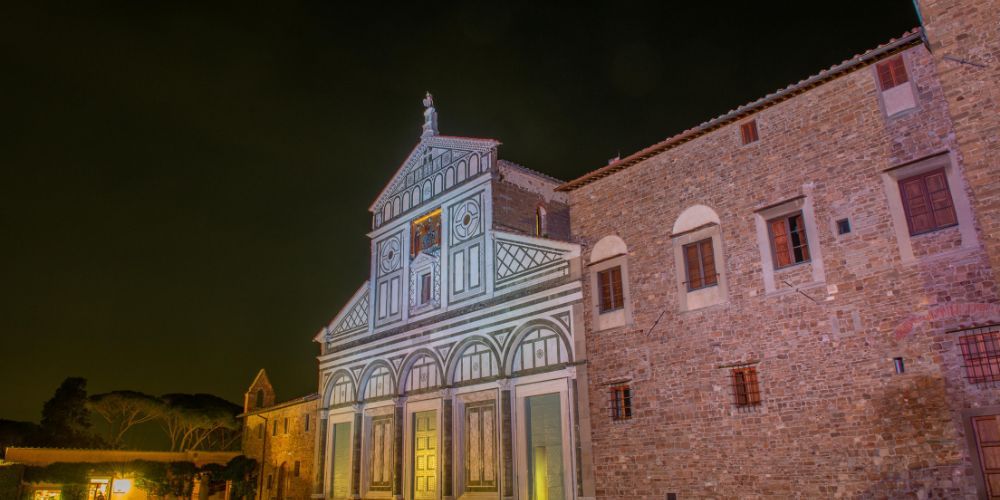
Among the ancient stones of the crypt lies a legend that continues to captivate across the centuries. Minias, according to tradition, was no ordinary man. Some accounts describe him as an Armenian prince, others as a Roman soldier or pilgrim who arrived in Florence during the fierce persecutions of Christians in the 3rd century. Tortured and sentenced to death for refusing to renounce his faith, Minias is said to have defied death itself: after his decapitation, he miraculously stood up, gathered his head, and walked to the top of the Mons Florentinus (the hill where the basilica now stands) where he finally collapsed and died.
This miraculous act made San Miniato the first Christian martyr of Florence, and it is this legend that has consecrated the crypt as the most sacred part of the entire complex.
But the story doesn’t end there. Throughout the basilica, mysterious symbols weave through the architecture, rooted in medieval thought: sacred geometries, allusions to alchemical wisdom, and esoteric structures have drawn scholars and seekers alike. Over time, many have attempted to decode the hidden language carved into the forms and spaces.
Unique experiences for visitors: guided tours, evening events, and open restoration sites
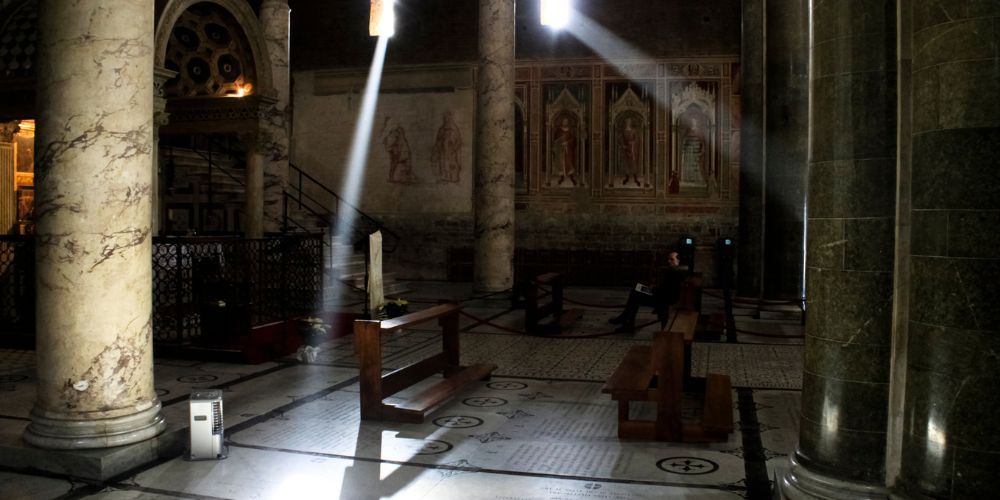
A visit to the San Miniato al Monte crypt can become an even more immersive experience thanks to the special initiatives organized by the basilica and the monastic community. In addition to free entry, expert-led guided tours are available, offering insight into the millennia-old history of the complex, the frescoes by Taddeo Gaddi, the hidden symbols among the columns, and the enduring legends that linger within its walls.
What makes the experience even more evocative are special events that blend culture and spirituality. At certain times of the year, sacred music concerts and guided meditation gatherings are held, taking full advantage of the crypt’s remarkable acoustics and intimate atmosphere.
Equally fascinating is the opportunity to witness ongoing restoration efforts through the so-called “open sites,” where visitors can observe the careful work of preservation up close, becoming not just spectators, but silent witnesses to the care and rebirth of a cultural treasure.
Conservation and restoration of the San Miniato al Monte crypt
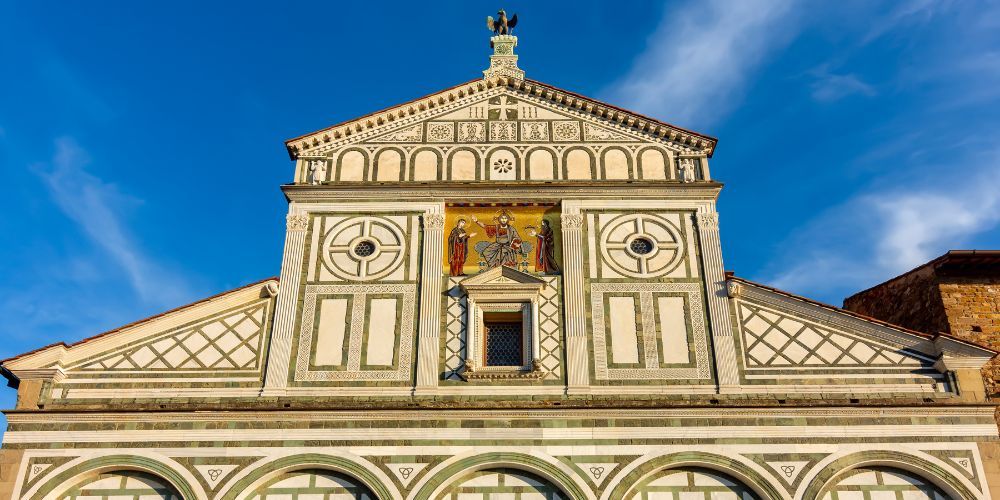
The San Miniato al Monte crypt has been the focus of significant conservation and restoration efforts aimed at both structural safety and artistic preservation. Between 2022 and 2023, key interventions were carried out to consolidate the crypt’s walls and pillars and address existing cracks and damage. These restorations, guided by in-depth analyses of original materials and historical construction techniques, made it possible to safeguard the Romanesque architectural features and the precious frescoes that line the space.
In 2024, a more extensive restoration project began, funded with over €3.6 million through Italy’s National Recovery and Resilience Plan (PNRR). This initiative includes seismic retrofitting, roof reinforcement, wall repairs, and the restoration of the basilica’s striking polychrome marble façade.
Modern technology is playing a crucial role in the preservation process. Digital models and structural monitoring sensors are being used to detect micro-movements, enabling a proactive approach to preventive conservation. This not only ensures the long-term protection of the crypt but also contributes to the ongoing preservation of one of Florence’s most important Romanesque treasures.
The San Miniato al Monte crypt compared to other historic crypts in Florence
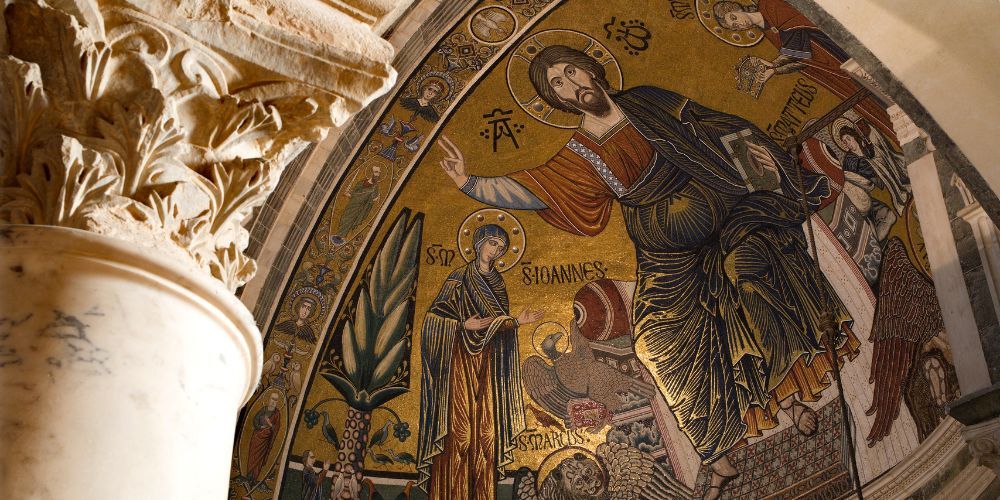
Among Florence’s historic crypts, the San Miniato al Monte crypt stands out for its rare balance of sacredness, antiquity, and architectural purity. It remains one of the most pristine and authentic examples of Florentine Romanesque architecture, a space that not only houses the relics of the city’s first martyr but also preserves an atmosphere of deep, understated spirituality.
Unlike other crypts in the city, San Miniato has retained its liturgical and devotional function. Consider the Medici Chapels in the Basilica of San Lorenzo, where the crypt serves as an opulent dynastic tomb, a celebration of grandeur in marble and sculpture, showcasing the splendor of Renaissance and Baroque art in honor of the Medici family.
Beneath Florence Cathedral lies the crypt of Santa Reparata, offering yet another perspective. This space is primarily archaeological, preserving remnants of the ancient paleochristian church, including mosaics, early foundations, and the tomb of Filippo Brunelleschi. While invaluable for understanding the city’s early Christian roots, it lacks the living spiritual resonance found in San Miniato.
Even the Medici Chapels’ octagonal crypt, with its perfect geometry and focus on funerary rites, carries a more political and celebratory tone than mystical.
Who was Saint Minias and why is he important to Florence?
The figure of Saint Minias is wrapped in centuries of legend and devotion. Venerated as the first Christian martyr of Florence, Minias embodies unwavering faith and spiritual identity for the city. His significance extends beyond religious worship to the very place that preserves his memory: the Abbey of San Miniato al Monte, built on the exact spot where, according to tradition, he came to rest after his martyrdom.
Ancient sources describe him in various ways, some say he was an Armenian prince, others a Roman soldier or a Greek merchant. But all versions converge on the same destiny of persecution and courage. Around 250 AD, under the rule of Emperor Decius, Minias was arrested for his Christian beliefs, tortured, and eventually beheaded.What elevated him to legend was the miraculous act that followed: after his decapitation, he is said to have picked up his own head and walked up to the top of the hill now known as Mons Florentinus, the very place where the abbey would later rise in his honor.
What are the magical symbols found in the San Miniato al Monte crypt?
The San Miniato al Monte crypt holds a captivating blend of Christian and cosmic symbols that enhance its aura of mystery. One of the most striking is the summer solstice event: a single ray of sunlight enters the basilica and illuminates the Cancer zodiac sign engraved into the floor, a moment of perfect alignment between heaven and earth, between faith and astronomy.
The cross-vaulted ceilings, frescoed by Taddeo Gaddi, feature saints and martyrs, creating a dialogue between sacred imagery and architectural form. In the central nave, geometric shapes like circles, octagons, and squares appear, ancient symbols of spiritual transformation.
There are also references to the golden ratio and the chalice, symbols of harmony and intuition. Every element speaks of a church designed not only to be admired, but to be read, interpreted, and deeply experienced.
How can I visit the San Miniato al Monte crypt?
The Abbey of San Miniato al Monte is open to visitors every day, and entry is completely free of charge.
Current opening hours are:
Monday to Saturday: 9:30 AM – 1:00 PM and 3:30 PM – 7:00 PM
Sundays and public holidays: 8:15 AM – 1:00 PM and 3:30 PM – 7:00 PM
During liturgical celebrations, access to the crypt is not permitted, as the basilica returns to its primary function as a place of worship.
Are there any legends linked to San Miniato al Monte?
Yes, and within the basilica’s ancient walls lives one of Florence’s most mysterious and fascinating legends. According to tradition, in 250 AD, Minias was persecuted under Emperor Decius for refusing to worship pagan gods. He endured brutal torture, including being thrown into a blazing furnace, from which he miraculously emerged unharmed. But even his decapitation was not the end of his story.
Legend has it that Minias rose to his feet, picked up his own severed head, and walked to the top of Mons Florentinus, the very hill where the basilica now stands. There, he finally collapsed and died. That miraculous act led to the construction of the sanctuary in his honor and earned him the title of a cephalophore, a saint who carries his own head.
This powerful story cements the crypt that holds his relics as the holiest part of the entire complex.
Layered onto this are subtler symbols, such as the number five (associated with the fifth element, or quintessence) and the zodiac sign of Cancer, engraved into the floor and illuminated each year by a beam of sunlight during the summer solstice.
What architectural features make San Miniato al Monte unique?
San Miniato al Monte stands out for its remarkable harmony between Romanesque architecture and spiritual symbolism. The white and green marble façade is among the most elegant in Florence, crowned by a golden mosaic from the 13th century that glows in the Tuscan light.
Inside, the central nave features a striking rhythm of alternating marble and painted terracotta capitals, while the marble-inlaid floor is adorned with zodiac signs and geometric shapes, each rich in symbolic meaning.
The 11th-century crypt, with its varied columns and capitals, remains one of the basilica’s most atmospheric spaces. Above it, the raised presbytery (with its Romanesque pulpit and large mosaic in the apse) adds a dramatic visual dimension.
Among the more curious elements are the functioning solstitial sundial and the sacristy frescoes by Spinello Aretino. Together, they reveal San Miniato as a place where faith, art, and astronomy coexist in a rare and perfect balance.
Can I take photos inside the San Miniato al Monte crypt?
Yes, photography is allowed inside the crypt of San Miniato al Monte, but only without flash.
What to see near San Miniato al Monte
The beauty of San Miniato al Monte extends far beyond its walls. The hill it stands on offers one of the most breathtaking views of Florence, making it an ideal starting point for a deeply atmospheric itinerary.
Just a few steps downhill lies Piazzale Michelangelo, famous for its panoramic view over the city, domes, towers, and red rooftops stretch out below, framed by the Arno River and surrounding hills. It’s the perfect place to take in all of Florence at a glance.
Nearby, the Rose Garden (Giardino delle Rose) offers a poetic break: a peaceful space filled with fragrant blooms and contemporary sculptures by Jean-Michel Folon. On the same hill stands the Church of San Salvatore al Monte, a lesser-known Renaissance gem with timeless charm. A little further down, you’ll find Porta San Niccolò, the only medieval gate in Florence that still preserves its original height, a striking reminder of the city’s ancient defenses.
Is San Miniato al Monte accessible for visitors with limited mobility?
Due to its hillside location and the presence of numerous steps, San Miniato al Monte is not fully accessible to visitors with mobility challenges. However, it's always advisable to contact the church office in advance to inquire about specific accommodations or available services.
About the author
Written on 13/11/2025



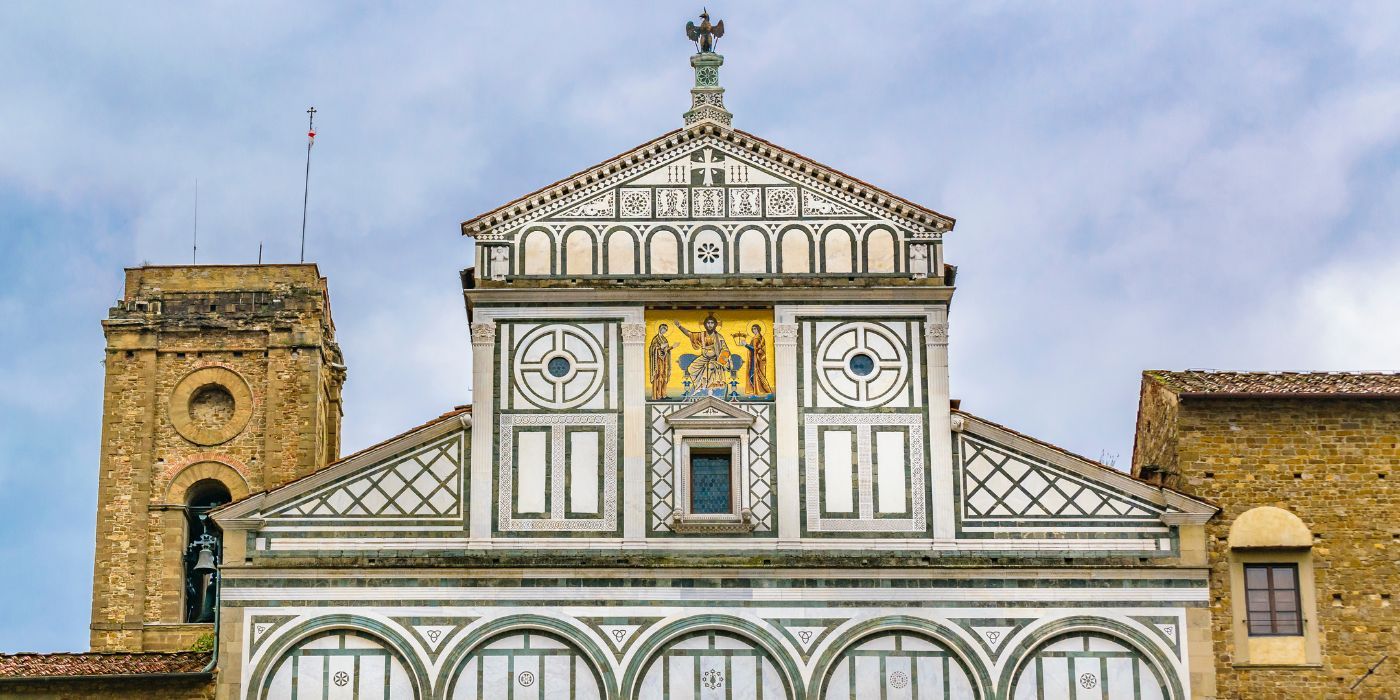

Flavia Cantini
Crypt of San Miniato al Monte: frescoes, symbols, and legends in the oldest part of the basilica, resting place of Florence’s first martyr.